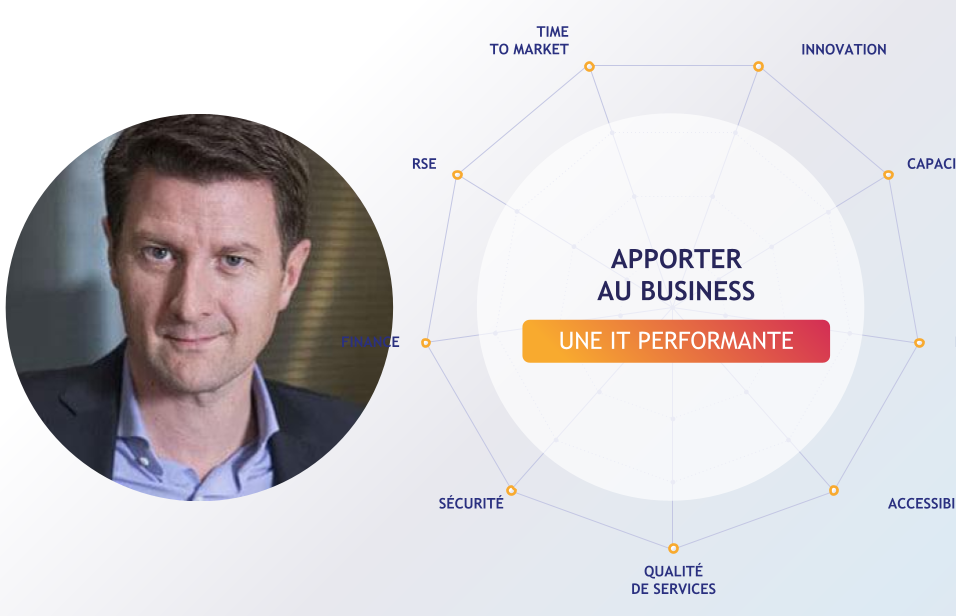Lucernys has been involved in IS performance since its inception and has chosen to reorganize its offer around this core philosophy. The objective? Make a difference with a 360° approach, capable of supporting the business on technical, organizational and financial levers. An update from Bernard Schmitt, president of Lucernys.
Three years ago you changed your name with the ambition of positioning Lucernys as a digital transformation scout – you talked about digital metamorphosis. Today, you choose to put forward a new tagline, on IT Performance. Why this new signature, which is also a strong statement, and what is the path that led Lucernys to make this choice?
We made this choice because we believe that digital transformation is a means and not an end. We always put ourselves on the side of the business and we are interested in his objectives. Digital transformation as such does not interest the business. What interests him is to do business and to have at his side a powerful IT to realize this business. Digital transformation is a way – in this case a rather efficient way – to support the business in the development of its business. In reality it is a change of prism. We are not talking about means, but about common objectives between IT and the business.

“Transformation is not an end but a means”
You have organized your offer around what you consider to be the major challenges facing the IT department and the solutions needed to address them. How would you define these issues today?
These are all issues that are on the business side: what does the business want, what does it expect from an efficient IT department? So what does it mean to be successful for an IT department? It means quickly making available to the business innovative solutions on the market, high-performance applications from both a functional and technical point of view, based on a robust and accessible information system, i.e. one that can be used from anywhere, at any time and with any device, including by people with disabilities – we are talking about societal performance here.
An efficient IT system must also ensure an irreproachable quality of service, based on the robustness of the IS but also on an agile and reactive operating model, particularly in the rapid processing of requests or incidents when they arise. It is also a safe computing, – which has become more important with Covid – and at a reasonable price, adjusted . Finally, to come back to the societal aspects, it is a computer that respects the environment and society. This is what really drives the business.
Over the years, we have realized that this is what makes up the plural performance of ISD. Year after year, we have built offers, bricks of offers that we have assembled and that today form a consistent and homogeneous whole that we offer to CIOs in order to accompany them towards these objectives of excellence.
You talk about performance issues, but how do you get there? How can we avoid the common pitfalls that hinder this goal?

“We are looking to remove the barriers, area by area.”
It is true that you can always start with a scratch IT system and decide: “these are the best technical, organizational, etc. bricks we need to have an efficient IT system”. The fact is that, as a rule, you have to deal with an existing situation. So the first step is to characterize the performance of the IT department with regard to its various challenges and to identify all the obstacles that come with each of them.
Our approach is therefore cross-functional: we start with the business, go through Devs to Infras and Ops, and go through the product lifecycle in order to identify the obstacles inherent to each of the IT domains – i.e. Devs, Infras and Ops – but also the interfaces between each of these domains. Through this approach, we start from a situation from which we will remove the obstacles, area by area, in order to achieve operational excellence in each of the performance areas.
So the last stage of the rocket is the method to remove all these brakes. How do you operate?
The first step is to identify these obstacles. “To know is to be able to”: if one does not “know”, obviously one cannot “can”. This crucial step consists of conducting interviews with all the stakeholders in the product lifecycle, whether they are from the business or from IT. We are really trying to corroborate each other’s perceptions. Then we try to objectify it through hard and soft KPIs. We will thus benchmark the organization according to KPIs that reveal the performance of the IT department. What is the part of the build versus the run? What are the internal or external daily rates? What is the ratio of interns to externs? How are the activities of design, realization, acceptance distributed?

“we offer a benchmark of performance revealing KPIs”
And also the function points: this is where we start from the expression of a need, which we translate into function points. We give points for each feature knowing that one feature point on the market is worth so many days of build for a given technology, from design to dev to integration. This way, we can evaluate the performance of the application build for a given product. For example: “This project is worth 100 points. But these 100 points represent 120 days on the market in this technology and they are realized in the company in 140 or 80”. Once again, this is a very pervasive evaluation.
Once we have identified where the obstacles lie, it is then possible to propose detailed recommendations. This qualitative and quantitative assessment allows us to identify where the problems come from and to propose plans for remediation, improvement or transformation. And this on all the axes mentioned, i.e. technical, organizational and financial issues. We play all the games to improve performance at 360 degrees.
Is your scope of intervention limited to diagnosis and audit?
No, although I think one of the strengths that differentiates us is this 360-degree approach, both qualitative and quantitative, in which we corroborate a large number of observations. But beyond this crucial phase, we support the implementation of the transformation plans defined in the framework of the recommendations we have made.
Finally, the last step consists, once we have transformed and improved, in constantly monitoring and controlling that there are no drifts. We are therefore in line with a logic of continuous improvement with offers such as TBM – Technology Business Management -, in a holistic way, and in a more targeted way of TEM – Telecom Expense Management – or FinOps Cloud to keep under control, more under a financial aspect of things, the performance of solutions.
How do you think this approach is very differentiating in the market?
Our difference lies in our ability to analyze at 360° and to place ourselves firmly on the side of the business, because that’s what the IT department works for. These are its challenges. This explains our new tagline: let’s not talk about means anymore, let’s talk about objectives. Our mission is to improve the performance of the IT department alongside the business in order to serve its interests at all levels. We don’t just do technical, organizational or financial work, but we have a 360° view of things.

“We advise but also drive transformation or continuous improvement.”
On the other hand, our approach is qualitative and quantitative. When we make a diagnosis, we back it up with numbers. There are companies or panelists that do benchmarking, and others that do qualitative consulting. Lucernys is truly at the confluence of the two. Moreover, it is not so common to pilot the transformation beyond the diagnosis. We don’t just say what needs to be done, we do it. Finally, and this is unique, we also drive continuous improvement. We carry out regular measurements. For some clients, we do this on a multi-year basis in order to observe and manage performance.
This offer has been built up over the years. Today, we have completely redesigned our offer, which is reflected in our new tagline. We have put together all the building blocks and we can give this general sense of our approach which is also better understood than in the past. We had a catalog of interventions that lacked a bit of a link, even though we obviously had this trajectory in mind. Today, it makes sense and we can expose it much more clearly to the market.







